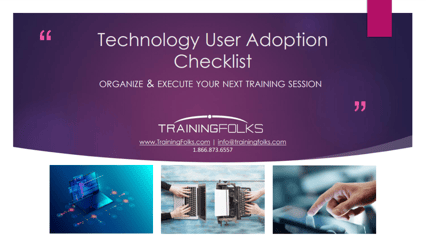How to Drive Technology User Adoption

It's without any doubt that technology has become a critical component in the modern business environment. Using technologies organizations communicate faster and seamlessly when training is done effectively. For example, Salesforce training, Workday training, and SAP training are critical when they are implemented. In addition, storage, processing, and retrieval of information is no longer a problem. But all these can't be true if we don't know the best way to adopt the technology.
To ensure successful technology user adoption, you should know how to handle and use new technical concepts. Also, you need to be able to know which option is the most appropriate for your organization. Below are five tips you can use to drive technology user adoption.
1. Align Technology and Strategy
Aligning the technology you intend to bring on board with your business strategy could produce the best results as technology user adoption is concerned. The alignment means that the new technology works in agreement with all your business plans and ambitions.
So, before you go ahead to implement a given technology, assess all your business needs and ensure that whatever you're bringing on board will address these issues effectively. For example, if you want to purchase new financial management software, the application should meet the organization's needs. Moreover, launching the new software should address a problem or need that you have.
The other critical factor you will want to consider for seamless technology user adoption is the cost of the new technology. You don't want to launch something new with a bad return on investment. So, for ideal user adoption, the technology in question must be cost-effective and addresses your organization's pain points. This way, employees see the benefit of the change being implemented and are more likely to adopt it.
2. Communicate for buy-in and Engagement
In this case, you want to begin by studying and understanding all your stakeholders. So before conducting any tech-related deployment, you should consider finding out what your employees or end-users think is best for the organization. What do they need from the new software, and will this change deliver that for them?
First, you need to spend some time with your employees talking about the new technology or idea you intend to bring in. Then, give them a chance to express their views. This is a critical step to get their feedback and ultimately their approval. Ensuring that those who will be affected by the change are excited and motivated will ensure user adoption.
3. Perform a Current Systems Analysis
No system can ever be 100% perfect. There are always going to be some challenges with what you use currently. So, to avoid deploying a new system with similar problems, you want to extensively assess the current one and note down all the issues.
However, the journey doesn't end there; you also want to know if you'll need any additional features on the system. Therefore, in this case, you should engage all the associated departments. Evaluate the levels of their satisfaction with the current platform. Ask them if they are experiencing any problems while operating the system. Also, you should find out if there are any suggestions they want to make.
4. Develop your Training Approach Early
User adoption training is an essential component of successful technology implementation. You don't want to wait until deployment before you can begin training your employees on a given technology.
Select the right training approach and create an effective learning plan. This may involve designing training that is based on eLearning, delivered in the classroom by an instructor or virtual Instructor.
5. Monitor and course correct
It's not always a guarantee that everything will go as planned. Sometimes, the outcome may not be what you expected. So, to ensure you meet your technology adoption goals, it's crucial to monitor the performance before, during, and after implementation. This will allow you to change course if you notice something isn't going to plan, or spend more time on topics your learners show interest in.
Ensure your next training session engages and excites your learners.
Get our FREE eBook Download 'Technology User Adoption Checklist'
for the top tips and tricks.


